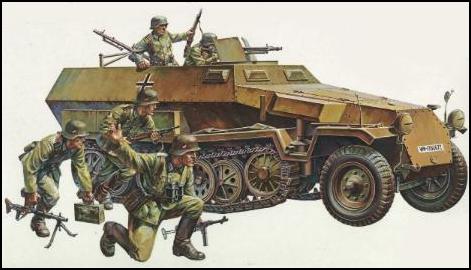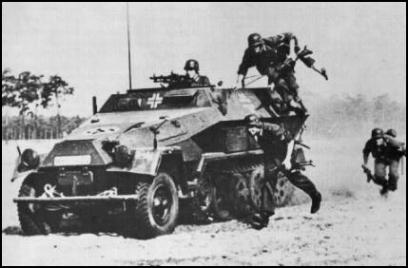The driving force behind the transition from foot soldiers to mechanized warriors was the German Army of WWII whose own terminology combined the old and new in memorable style.The infantry units of the tank divisions were christened panzergrenadiers.Their half-tracked vehicles were the most distinctive of the war.
While the British and French persisted in regarding the tank as primarily an infantry support weapon to be distributed in small units among the infantry divisions , the German Army followed the Soviet lead.The Reichswehr's secret training programme on the Red Army tank grounds paid enormous dividends.German tanks were to be concentrated in discrete armored divisions with accompanying infantry , artillery , anti-tank , anti-aircraft and even re-supply columns all mounted in vehicles with as high a proportion as possible capable of off road movement.Half-track vehicles were already in service as artillery tractors.Their cross country capability was not as great as a fully tracked vehicle but they were cheaper and quicker to manufacture , being essentially trucks with the rear wheels replaced by a track unit.It was a short step to consider them as infantry transports for the panzergreanadier regiments.
The idea was to fit a lightly armored shell to a half-track chassis.Development began in 1937 , Hanomag undertook the design of the chassis while Büssing-NAG produced the armored body.The vehicle used as a basis for the design was the three-tom prime mover the SdKfz 11.Designated the Sd Kfz 251 , Allied source later referred to as the Hanomag , the German Army term for such vehicles was Schützenpanzerwagen abbreviated to SPW.Series production commenced in June 1939 and continued until September 1943.
The basic infantry carrier was fitted with a 7.92mm machine gun behind a small armored shield at the front.Asecond machine gun was located at the rear on a high-angle mounting.The two man crew remained in the vehicle but the infantry section in the open troop compartment deployed via twin rear doors.The second most numerous sub-class looked almost identical being the ammunition carriers for the tank and artillery units as well as the machine gun and mortar companies of the panzergrenadier battalions.There were numerous other variants some developed in 1939-1940 , others right at the end of the war on Hitler's personal orders.
There was only one problem with the Sd Kfz 251 there were never enough of them.The numbers built fell far short of the quantity needed to equip every panzergrenadier unit.In general only one of the four or six panzergrenadier battalions in a panzer division would be mounted in half-tracks the bulk of the troops remained in lorriers.This severely reduced the ability of the panzergrenadiers to fight in conjunction with the tanks.Their unarmored trucks were vulnerable to enemy fire and had only limited cross -country mobility.The battalion in half-tracks could not be everywhere at once.Ironically the balance between armored infantry and tanks that the proponents of the panzer divisions intended was achieved to some extent during the war because the number of tanks in each formation was often short of the authorized strength.
|


